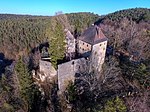Unterailsfeld Castle
Castles in BavariaGößweinstein
The burgstall of Unterailsfeld Castle (German: Burgstall Unterailsfeld) is the site of a medieval lowland castle situated at a height of 360 m above sea level (NHN) in the village of Unterailsfeld, in the market municipality of Gößweinstein in the county of Forchheim in the south German state of Bavaria. In 1525 its owners were named as the lords of Eyb. The castle was destroyed during the Peasants' War. No above ground ruins of the old castle have survived.
Excerpt from the Wikipedia article Unterailsfeld Castle (License: CC BY-SA 3.0, Authors).Unterailsfeld Castle
Unterailsfeld,
Geographical coordinates (GPS) Address Nearby Places Show on map
Geographical coordinates (GPS)
| Latitude | Longitude |
|---|---|
| N 49.806226 ° | E 11.345089 ° |
Address
Unterailsfeld
Unterailsfeld
91327
Bavaria, Germany
Open on Google Maps








